Ten Chevrolet trucks that built a global brand
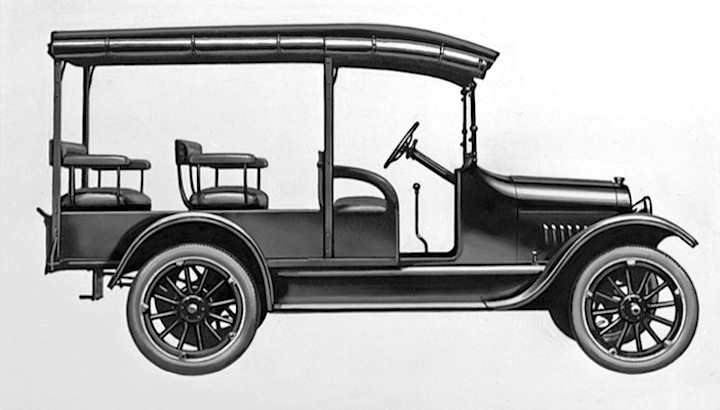
(May 8, 2014) DETROIT — Chevrolet captured the spirit of 20th Century America, with its “work hard, play hard” ethic. And perhaps no Chevrolet represents this spirit better than the Chevy truck.
Founded in Detroit on Nov. 3, 1911, Chevrolet produced only cars through 1917. The company added its first truck models in January 1918, and has built tens of millions since.
“From the beginning, Chevrolet has offered dependable, long-lasting trucks that help people make a living, enjoy life and get things done,” said Chris Perry, vice president, global marketing and strategy for Chevrolet. “These core values are represented today by our successful Silverado, Tahoe and Suburban models, and by our all-new global mid-size trucks, which build on Chevy’s strong truck DNA.”
Chevrolet has built an amazing variety of trucks for individual and commercial customers over the decades. Here are 10 noteworthy examples through the decades:
1. 1918 Chevrolet 490 Half-Ton Light Delivery “Cowl Chassis” (pictured at top)
Two four-cylinder models marked Chevrolet’s entry into the truck market in January 1918. Both were “cowl chassis” units that came from the factory with only frontal sheet metal. It was customary at the time for the buyer to obtain a wooden cab and cargo box or panel van body to suit their purposes.
Priced at $595, the half-ton Light Delivery cowl chassis was essentially a body-less Chevrolet 490 car equipped with stronger rear springs. Mounted with a pickup box or panel body, it provided an agile and economical light-delivery truck for ‘Main Street’ businesses.
The one-ton capacity 1918 Chevrolet “Model T” (presumably for “Truck”) cost $1,125 without body and was built on a truck frame than was longer and stronger than that of the half-ton model. A 37 horsepower engine gave the larger truck the power to haul heavier loads at a governor-limited top speed of 25 mph.
During the “Roaring ’20s,” trucks and trucking came of age, as commerce, construction and road building boomed. Chevy truck sales soared during the decade to new annual records through 1929, when 187,103 were sold.
For 1929, Chevrolet introduced the six-cylinder engine that became the legendary “Cast-Iron Wonder.” From that point until mid-1955, all Chevy light trucks would be powered by six-cylinder engines. After 1930, most light-duty Chevrolet trucks were delivered with a factory-built cab and cargo box or body.
2. 1925 Chevrolet Half-Ton Panel Van – Brazil
In the United States, any decades-old Chevrolet truck is rightly considered a piece of genuine Americana. But Chevrolet trucks run deep in the cultural heritage of other countries as well, especially in rest of the Americas. The trucks’ global presence dates back to the early 1920s, when General Motors established a worldwide network of 18 plants to assemble Chevrolet cars and trucks. The first plant, located in Copenhagen, Denmark, built its first Chevrolet -- it was a truck – on Jan. 7, 1924.
While customers worldwide developed an affinity early on for Chevrolet trucks, the brand has enjoyed a passionate following in Brazil for more than 85 years.
The first Chevrolet truck was assembled in Brazil was fitted with a locally made panel van body and completed in September 1925. Brazil had one of the most rapidly expanding economies in the world at the time, and it took little more than a year for the GM do Brasil subsidiary to book its first 25,000 vehicle sales. Millions more have since followed.
By the late 1950s, GM do Brasil was manufacturing Chevrolet Amazonas pickups and other truck models designed for that nation’s truck buyers. They were also exported regionally.
Today, Brazil represents Chevrolet’s second-largest market globally. Only in the United States are more Chevrolet cars and trucks sold each year.
3. 1937 Chevrolet Half-Ton Pickup
In the mid-1930s, as the U.S. economy began to recover from the Great Depression,
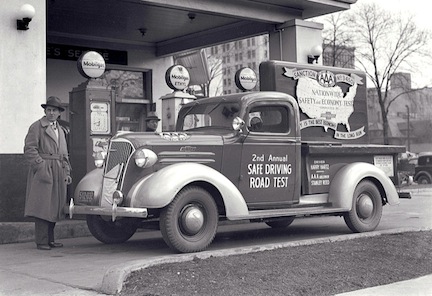 Chevrolet pushed for leadership in a reviving truck market with some of the strongest, most innovative and “modern” models produced to that point.
Chevrolet pushed for leadership in a reviving truck market with some of the strongest, most innovative and “modern” models produced to that point.
The Chevrolet Pickup for 1934 was designed from the ground up to withstand the rigors of truck service – prior half-ton models had been built on chassis adapted from passenger-car designs.
During 1935, Chevrolet introduced the Suburban Carryall, built on a half-ton chassis. This ‘truck wagon’ could carry up to eight people, or a crew and all of their gear, just about anywhere there was a road. Its durable steel body made the new model easier to maintain than the wood-bodied station wagons of the period. With the 1935 Suburban Carryall, Chevrolet essentially invented the SUV.
For 1937, Chevrolet introduced new trucks with streamlined styling that many still consider the best designs of the era. The ’37 also featured a sturdier body and a larger and more powerful 78-horsepower engine, among other improvements.
A 1937 Chevrolet half-ton pickup was sent on a grueling 10,245-mile drive around the United States that was monitored by the American Automobile Association (AAA). Carrying a 1,060 lb. load, the truck averaged 20.74 miles per gallon.
4. 1947 Chevrolet Advance-Design Half-Ton Pickup
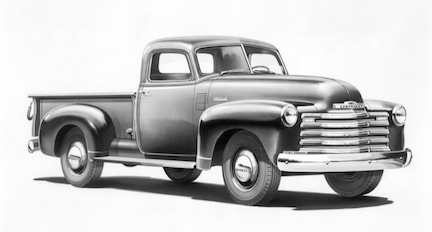 In early 1947, Chevrolet introduced its Advance-Design trucks, the first completely redesigned GM vehicles to appear following World War II. Owners of earlier pickup models had asked for a roomier, more comfortable cab with improved visibility, and a wider pickup box. They got all of that and much more.
In early 1947, Chevrolet introduced its Advance-Design trucks, the first completely redesigned GM vehicles to appear following World War II. Owners of earlier pickup models had asked for a roomier, more comfortable cab with improved visibility, and a wider pickup box. They got all of that and much more.
Designers sought to make the truck’s styling clean, brisk and attractive. Headlamps were now set wide apart in the front fenders and five horizontal bars made up the grille. The design was produced with few major changes from 1947 through 1953, and was then continued with a new frontal appearance into early 1955.
During the Advance-Design trucks’ run, there was a measurable shift among Chevrolet customers to trucks. Prior to World War II, the production ratio of the brand’s cars to trucks had been about 4:1. By 1950 – the year Chevrolet became the first brand to sell more than 2 million vehicles in a single year – the ratio of cars to trucks was closer to 2.5:1.
Today, the vintage Advance-Design models are favored by collectors, hot-rodders and customizers. The classic look was echoed in the designs of the 2003-2006 Chevrolet SSR roadster, and more recently, the HHR compact crossover SUV.
5. 1955 Chevrolet Cameo Pickup
Boldly modern styling gave the all-new “Task-Force” trucks introduced by Chevrolet in mid-1955 a fresh and modern look. Under the hood, the new overhead valve Chevrolet “small-block” V-8 that was causing such a stir in the 1955 Chevrolet cars was an option in many of the brand’s new truck models.
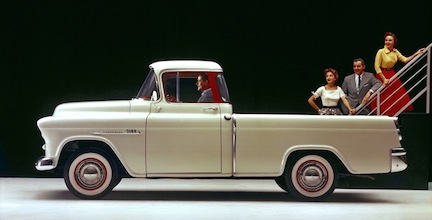 New to the 1955 truck line was the Cameo pickup, a high-styled “gentleman’s pickup” more at home in a trendy suburban “California bungalow” driveway than on a farm or in a factory yard.
New to the 1955 truck line was the Cameo pickup, a high-styled “gentleman’s pickup” more at home in a trendy suburban “California bungalow” driveway than on a farm or in a factory yard.
A major engineering advance with tremendous future implications was announced for 1957, when a factory-installed 4-wheel-drive system became available for the first time on select models.
Chevrolet continued the Task Force trucks with annual updates through 1959. During 1958, a new slab-sided Fleetside box option provided an alternative to Chevrolet’s traditional step-side pickup box.
6. 1959 Chevrolet El Camino Passenger-Car Pickup
The original El Camino introduced for 1959 combined the dramatically finned styling of that period’s Chevrolet cars with half-ton pickup utility. After 1960, the El Camino went on a three-year hiatus.
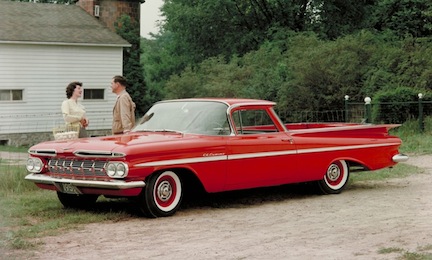 Chevrolet revived the El Camino “personal pickup” concept for 1964, with a new version based on that year’s new mid-size Chevrolet Chevelle. During the ‘muscle car’ era that followed, El Camino buyers could order their truck with a Chevrolet high-performance big-block V-8 powertrain, creating a sport pickup that could “haul” in more ways than one. By 1968, a complete Super Sport package was available.
Chevrolet revived the El Camino “personal pickup” concept for 1964, with a new version based on that year’s new mid-size Chevrolet Chevelle. During the ‘muscle car’ era that followed, El Camino buyers could order their truck with a Chevrolet high-performance big-block V-8 powertrain, creating a sport pickup that could “haul” in more ways than one. By 1968, a complete Super Sport package was available.
The Chevelle El Camino enjoyed a devoted following and was produced through two more styling generations (1968-1972 and 1973-1977).
For 1978, the El Camino was successfully transitioned to that year’s new, smaller Chevrolet Malibu platform. The final El Caminos were 1987 models. A quarter of a century later, requests and suggestions for a new El Camino are still received by Chevrolet.
7. 1967 Chevrolet C-10 Pickup with CST Package
It took only one glance at any of the 35 Chevrolet C/K models for 1967 to see that Chevy trucks had a new look that year. The exterior profile, which would characterize Chevrolet C/K models through 1972, featured a lower-silhouette cab and large, rounded wheel openings. The new chassis had coil springs front and rear.
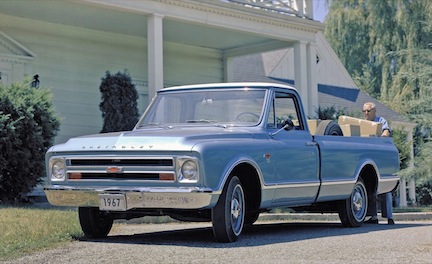 A new-for-1967 Custom Sport Truck package was a trend-setting option that included deluxe, car-like upgrades inside and out. The package could even be ordered in combination with bucket seats.
A new-for-1967 Custom Sport Truck package was a trend-setting option that included deluxe, car-like upgrades inside and out. The package could even be ordered in combination with bucket seats.
Other emerging market dynamics were taking Chevrolet trucks in new directions.
By 1967, the Federal Interstate Highway System was giving Americans unprecedented access to the nation’s natural wonders and recreational areas. Customers who enjoyed such pursuits appreciated the small-block and big-block V-8 power choices that gave Chevrolet trucks torque to pull trailers up grades, and horsepower to cruise comfortably with a camper at Interstate speeds.
The mid-1969 K-5 Blazer was a pioneering SUV that put the emphasis on sport. Based on a shortened wheelbase version of the standard Chevrolet 4x4 pickup’s half-ton chassis, the original K-5 Blazer was made for off-road adventure.
8. 1973 Chevrolet Suburban with Super Cheyenne Package
The Suburban for 1973 featured a new and roomier 4-door body that replaced the 3-door style produced during 1967-1972. It could carry up to nine passengers and was bigger, longer and stronger than any car-based station wagon. A new Cheyenne Super option package added new luxuries and comfort, while a 350-cid (5.7L) small-block V-8 was standard.
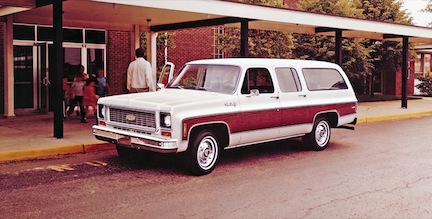 Available in 2WD and 4x4 models, the 1973 Suburban was part of a newly redesigned C/K truck line that broke production records. By the end of 1973, Chevrolet had become the first brand to both produce and sell more than 1 million trucks in a single year.
Available in 2WD and 4x4 models, the 1973 Suburban was part of a newly redesigned C/K truck line that broke production records. By the end of 1973, Chevrolet had become the first brand to both produce and sell more than 1 million trucks in a single year.
The 1973 models set the style for Suburbans produced through 1991. During those 19 years, Suburban became America’s premier vehicle for recreational travel, especially when towing a trailer was involved. The Suburban developed a considerable international following during this period as well.
The Suburbans of the 1970s and ’80s expanded the public’s awareness of the capabilities and possibilities of the 4-door SUV, which led directly to a proliferation of smaller editions in the 1990s.
In 2010, Chevrolet celebrated the Suburban’s 75th anniversary. In continuous production since 1935, Suburban is the auto industry’s longest-lived vehicle nameplate.
The 2012 Suburban stays true to its unique heritage, with maximum passenger room, cargo capacity and towing power.
9. 1999 Silverado 1500 Extended-Cab Pickup
Chevrolet’s 1999 full-size pickups were the first to carry the Silverado nameplate. They were the result of the most-intensive vehicle development initiative the American auto industry had yet seen.
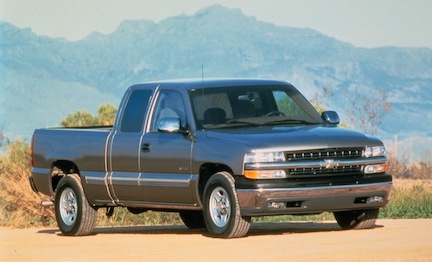 The styling of the new Silverado pickups gave more definition to the tautness of line that so successfully characterized the preceding 1988-1999 Chevrolet C/K trucks. Inside, all the comfort and luxury features demanded by a growing personal-use market were available.
The styling of the new Silverado pickups gave more definition to the tautness of line that so successfully characterized the preceding 1988-1999 Chevrolet C/K trucks. Inside, all the comfort and luxury features demanded by a growing personal-use market were available.
The biggest innovations were under the skin. Beneath the evolutionary styling was revolutionary construction – a new, super-strong, hydro-formed, multi-section modular frame.
Tahoe and Suburban full-size SUVs based on the new pickup architecture followed as 2000 models. For 2001, the first Silverado HD models established new heavy-duty three-quarter- and one-ton truck benchmarks for trailer tow ratings.
At the end of 2006, the second-generation 2007 Silverado pickups launched. Their platform was tuned to provide a smoother ride and responsive, confident handling. Powerful “Gen IV” small-block V-8 engines helped the trucks deliver higher towing and payload capacity. Advanced engine management technologies, improved aerodynamics, and even details such as tighter panel gaps aided fuel economy.
In 2011, as Chevrolet celebrated its centennial year, the Silverado HD was named Motor Trend Magazine’s “Truck of Year.” It was the eighth Chevrolet truck, and fourth Silverado Pickup, to win the honor.
10. 2013 Colorado Global Pickup
Chevrolet’s new global mid-size Colorado Pickup represents a historic and pivotal bid by Chevrolet to extend the brand’s global product and sales resurgence to its truck business.
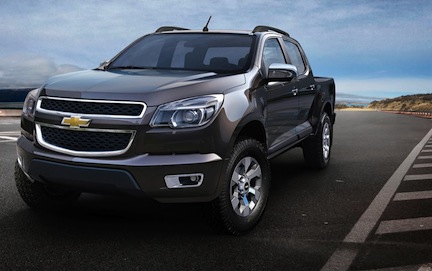 Developed under the direction of a truck-savvy team from GM do Brasil, the inaugural version of the global Colorado has entered production in Thailand and was officially launched there on Nov. 14, 2011.
Developed under the direction of a truck-savvy team from GM do Brasil, the inaugural version of the global Colorado has entered production in Thailand and was officially launched there on Nov. 14, 2011.
Representing the world’s-largest market for mid-size pickups, Thailand allows the new global Chevrolet truck to establish its bona fides in a globally competitive environment.
The new Colorado will subsequently become available in Brazil and other regions around the globe. Colorado will be built and sold in the United States as well, with product details and launch timing to be announced later.
Chevrolet has announced that it will also introduce an all-new midsize SUV carrying the TrailBlazer name into global markets, starting as a 2013 model. It will be based on the new global midsize truck platform and will combine the hauling and towing capability of an SUV with the ride, comfort and efficiency of a crossover.
